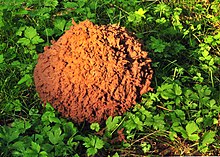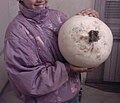Giant Puffball
Calvatia giganteaCalvatia gigantea 5
Description[edit]
Most giant puffballs grow to be 10 to 70 centimetres (3.9 to 27.6 in) in diameter, although occasionally some can reach diameters up to 150 centimetres (59 in) and weights of 20 kilograms (44 lb). The inside of mature Giant puffballs is greenish brown, whereas the interior of immature puffballs is white. The large white mushrooms are edible when young.[1][2]
The fruiting body of a puffball mushroom will develop within the period of a few weeks and soon begin to decompose and rot, at which point it is dangerous to eat. Unlike most mushrooms, all the spores of the giant puffball are created inside the fruiting body; large specimens can easily contain several trillion spores. Spores are yellowish, smooth, and 3 to 5 micrometres (0.00012 to 0.00020 in) in size.[1][2]
The classification of this species has been revised in recent years, as the formerly recognized class Gasteromycetes, which included all puffballs, has been found to be polyphyletic. Some authors place the giant puffball and other members of genus Calvatia in order Agaricales. Also, the species has in the past been placed in two other genera, Lycoperdon and Langermannia. However, the current view is that the Giant Puffball is Calvatia.[3]
Conservation status[edit]
"Widespread and fairly common, and not considered of conservation concern in the UK. However, it is protected in parts of Poland and considered rare in Lithuania and of conservation concern in Norway."[1]
Cooking[edit]
All true puffballs are considered edible when immature, but can cause digestive upset if the spores have begun to form, as indicated by the color of the flesh being not pure white (first yellow, then brown). Immature gilled species still contained within their universal veil can be look alikes for puffballs. To distinguish puffballs from poisonous fungi, they must be cut open; edible puffballs will have a solid white interior. Some similar mushrooms have the white interior (or yellowish) but also have the silhouette of a cap-type mushroom on the interior when cut open. These are young cap-type mushrooms and may be poisonous.
The meat of giant puffballs tastes very similar to tofu or melted cheese when cooked. To prepare, remove any brown portions and tough skin, which sometimes peels off easily. Do not soak in anything. Puffballs may be sauteed, broiled, or breaded and fried; they do not dehydrate well, but may be cooked and then frozen.
Resembles[edit]
Giant puffballs resemble the earthball (Scleroderma citrinum). The latter are distinguished by a much firmer, elastic fruiting body, and as an interior that becomes dark purplish-black with white reticulation early in development.
Images[edit]
References[edit]
- ^ abArora, David (1986). Mushrooms Demystified. Berkeley, California: Ten Speed Press. ISBN 0-89815-169-4. [page needed]
- ^ abBessette, Alan E. (1997). Mushrooms of Northeastern North America. Syracuse, NY: Syracuse University Press. ISBN 0-8156-0388-6. [page needed]
- ^Volk, First. "Tom Volk's Fungus of the Month for August 1998". Retrieved 6 October 2012.
Sources and Credits
- (c) Alan Wolf, some rights reserved (CC BY-NC), http://www.flickr.com/photos/90055788@N00/1358565822
- (c) anonymous, some rights reserved (CC BY-NC), http://www.biopix.com/photos/SDL-Langermannia-gigantea-00001.jpg
- (c) anonymous, some rights reserved (CC BY-NC), http://www.biopix.com/photos/SDL-Langermannia-gigantea-00002.jpg
- (c) anonymous, some rights reserved (CC BY-NC), http://www.biopix.com/photos/SDL-Langermannia-gigantea-00003.jpg
- Adapted by keeks from a work by (c) Unknown, some rights reserved (CC BY-SA), http://eol.org/data_objects/32138159














